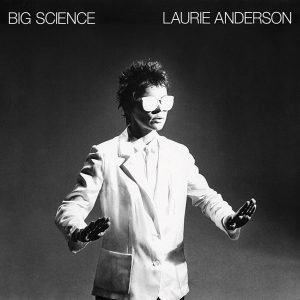Released in 1982, Big Science marked Laurie Anderson’s formal entry into the realm of recorded music, but it was anything but a conventional debut. A groundbreaking figure in performance art, Anderson had already spent the previous decade establishing herself as a master of avant-garde storytelling, weaving spoken word, multimedia visuals, and experimental instrumentation into her live work. Big Science was born out of her ambitious, multi-hour performance piece United States Live, a sprawling exploration of American culture, technology, and human connection. Rather than attempting to distill the entirety of that opus, Big Science functions as a focused excerpt—a concept album that captures the haunting, dystopian essence of Anderson’s artistic worldview.
In the broader music landscape of the early 1980s, Big Science arrived like a transmission from another dimension. The era was steeped in post-punk’s angular experimentation, new wave’s shiny futurism, and the blossoming use of synthesizers in pop music. Yet Anderson’s approach defied easy categorization. Blending minimalistic electronics, deadpan spoken-word delivery, and surrealist lyricism, she created a work that felt simultaneously cerebral and deeply emotive. The album’s centerpiece, the unlikely single “O Superman,” even reached No. 2 on the UK charts—a testament to its strange, hypnotic allure and Anderson’s ability to connect avant-garde ideas with mainstream audiences.
Sonic Exploration

The sonic landscape of Big Science is as meticulously crafted as it is otherworldly. Laurie Anderson, serving as the album’s primary architect, blends crisp production with an experimental edge, creating a sound that feels both futuristic and strangely timeless. The production is polished and deliberate, each element carefully layered to evoke a sense of both intimacy and detachment. This clarity allows every synthetic pulse, spoken word fragment, and orchestral swell to breathe, ensuring that even the album’s quietest moments carry weight and resonance.
Musical Arrangements
Anderson’s approach to musical arrangement is equally avant-garde. Traditional instrumentation is sparse, making room for innovative use of synthesizers, electronic processing, and unconventional sound sources. For instance, the album’s iconic opener, “O Superman,” centers around an austere two-note organ loop, its simplicity gradually enveloped by robotic vocoder vocals, birdlike chirps, and air-raid sirens. The effect is mesmerizing and unnerving, perfectly embodying the song’s meditation on vulnerability and mechanization. Similarly, tracks like “From the Air” feature jazzy bursts of brass, juxtaposed against dissonant, fragmented rhythms, as though assembling pieces of a sonic puzzle.
Vocally, Anderson’s delivery is unique and immediately recognizable—her voice is often spoken rather than sung, drifting between robotic monotone and a storyteller’s quiet warmth. The use of the vocoder, particularly on “O Superman,” turns her voice into a synthetic echo, blurring the boundaries between human and machine. This manipulation of vocals becomes a thematic extension of the album’s exploration of technology’s encroachment on the human experience.
Genre Elements
Musically, Big Science is a genre-blurring triumph. It touches on elements of ambient, minimalism, art pop, and even classical avant-garde, yet refuses to be confined to any one category. Tracks like “Big Science” and “Walking & Falling” channel the sparse, repetitive structures of minimalist composers like Philip Glass, while moments such as “Let X=X” incorporate a playful, almost dadaist approach to sound collage. Anderson’s use of silence and space is just as important as the sounds themselves, giving the music a haunting, meditative quality that feels distinctly modern yet rooted in ancient storytelling traditions.
Lyrical Analysis

At the heart of Big Science lies Laurie Anderson’s extraordinary lyrical vision—a blend of poetry, satire, and philosophical inquiry that challenges listeners to look beyond surface meanings. The central themes of the album are rooted in a profound exploration of modernity: the disconnection bred by technology, the surrealism of everyday life, and the fragile dance between control and chaos in contemporary society. Anderson’s lyrics often read like cryptic proverbs, loaded with ambiguity yet deeply evocative. Recurring motifs, such as flight, communication, and the human-machine relationship, thread the album together, creating a cohesive narrative about a world in flux.
One of the most striking examples of Anderson’s thematic depth is found in the album’s centerpiece, “O Superman.” Here, she deconstructs ideas of trust and vulnerability in a mechanized world, weaving together references to motherhood, government surveillance, and military power. The repeated line, “Here come the planes,” is deceptively simple yet haunting, evoking both literal and metaphorical threats from above. The lyric, “Cause when love is gone, there’s always justice / And when justice is gone, there’s always force,” unfolds like a modern-day lament, hinting at humanity’s tendency to replace connection with systems of power and control.
Throughout Big Science, Anderson’s lyrics are characterized by their abstract, open-ended nature. They rarely follow traditional narrative structures, opting instead for fragments of imagery and dialogue that feel like overheard conversations in a dream. On “Let X=X,” she layers absurdist humor with cryptic insights, playfully recounting mundane observations—“I met this guy. And he looked like he might have been a hat-check clerk at an ice rink”—that unfold into larger meditations on perception and identity. This surrealist style invites the listener to actively engage with the text, piecing together meaning like a puzzle.
Emotional Impact
Yet for all their abstraction, Anderson’s lyrics possess a deep emotional resonance. They evoke a wide range of feelings, from the uneasy detachment of “O Superman” to the wistful melancholy of “Walking & Falling.” Even her driest, most ironic observations carry an undercurrent of human vulnerability, as if she’s both inside and outside the systems she critiques. This duality—simultaneously analytical and empathetic—is what makes Big Science so powerful. Anderson doesn’t dictate how listeners should feel but instead creates a space for contemplation, inviting them to confront their own reactions to her words.
Cohesion and Flow

The brilliance of Big Science lies not only in its individual tracks but in how seamlessly they form a unified whole. Laurie Anderson’s meticulous attention to pacing and structure ensures that the album feels less like a collection of songs and more like a guided journey through a fragmented, futuristic landscape. Each track flows organically into the next, linked by shared sonic motifs and thematic threads, creating a sense of progression that feels both deliberate and fluid.
Track Progression
The album begins with “From the Air,” a surreal yet inviting overture that sets the tone for the entire work. Its disjointed imagery of a flight crew calmly preparing for disaster mirrors the precariousness of modern existence, immediately drawing listeners into Anderson’s world of wry observation and understated menace. The transition into “Big Science,” the second track, feels almost cinematic, with the steady percussion and haunting woodwind lines amplifying the sense of unease introduced in the opener. As the album unfolds, tracks like “Sweaters” and “Walking & Falling” act as moments of reflection, providing breathers between the more densely layered compositions.
This careful sequencing creates a rhythm that balances tension and release. The centerpiece, “O Superman,” anchors the album both thematically and emotionally. Its repetitive, hypnotic structure pulls listeners into a meditative state, serving as a kind of heart monitor for the album—steady, yet ominously fluctuating. The song’s placement in the middle of the tracklist ensures that its emotional weight reverberates through the tracks that follow, such as the disjointed playfulness of “Let X=X” and the unsettling calm of “It Tango.”
Thematic Consistency
Thematic consistency is one of the album’s greatest strengths. Each track, whether cryptic or direct, speaks to Anderson’s overarching exploration of technology, alienation, and the paradoxes of human connection. Even when the mood shifts—such as the transition from the mechanical loops of “O Superman” to the quirky, spoken-word vignettes of “Let X=X”—the album never feels disjointed. Instead, these shifts serve to expand the narrative’s scope, offering different perspectives within the same conceptual framework.
Musically, the cohesion is reinforced by Anderson’s reliance on recurring textures: minimalist synth patterns, her deadpan vocal delivery, and an ever-present sense of spaciousness in the production. These elements create a connective tissue that ties the more ambient pieces, like “Walking & Falling,” to the rhythmically dynamic tracks such as “From the Air.”
Standout Tracks and Moments
While every track on Big Science contributes to its enigmatic, cohesive vision, several songs stand out for their artistry, innovation, and emotional resonance. These tracks act as pillars of the album, highlighting Laurie Anderson’s talent for blending the cerebral with the visceral.
Key Tracks
“O Superman”
No discussion of Big Science is complete without spotlighting “O Superman.” This minimalist epic is the album’s most iconic track, a hypnotic piece built on an unchanging two-note organ loop and Anderson’s vocoded vocals. What sets this track apart is its ability to evoke profound emotional impact through its simplicity. The line “Here come the planes” reverberates with eerie prescience, as Anderson juxtaposes the mechanized and human worlds with chilling clarity. Its blend of absurdist humor, haunting vulnerability, and existential dread makes it the album’s emotional and thematic centerpiece.
“From the Air”
Opening the album, “From the Air” immediately draws listeners into Anderson’s surreal vision. The track features jazzy bursts of brass and Anderson’s deadpan narration of an imagined airline safety announcement gone awry. The tension between the song’s playful delivery and its unsettling message about imminent disaster captures the album’s overall tone: simultaneously wry and foreboding. It’s an unforgettable introduction that sets the stage for the avant-garde journey ahead.
“Let X=X”
“Let X=X” is one of the album’s more playful and abstract tracks, but its appeal lies in its blend of absurdity and insight. Anderson’s spoken-word delivery, full of humor and strange specificity, pairs with minimalist instrumentation to create a meditative yet whimsical atmosphere.
“Walking & Falling”
Despite its brevity, “Walking & Falling” is a standout for its simplicity and emotional depth. The track’s hushed vocals and sparse instrumentation create a reflective pause within the album. Anderson’s meditation on the act of walking—“You’re walking. And you don’t always realize it, but you’re falling”—is both literal and metaphorical, a poignant commentary on the fragility of progress and balance.
Memorable Moments
The vocoder in “O Superman”: The robotic treatment of Anderson’s voice transforms her human expressions into something alien and mechanical, perfectly encapsulating the album’s themes of technology and alienation. The way the vocoder blends seamlessly into the song’s minimal instrumentation is mesmerizing and deeply unsettling.
The brass interjections in “From the Air”: These bursts of sound inject an almost chaotic energy into an otherwise restrained track, mirroring the unpredictable nature of the song’s narrative about catastrophe.
The silence in “Walking & Falling”: Anderson’s use of negative space is as significant as her instrumentation. The brief pauses between phrases give the track a meditative quality, allowing the listener to absorb its quiet profundity.
Artistic Contribution and Innovation

When Big Science arrived in 1982, it did more than just announce Laurie Anderson as a recording artist—it redefined the boundaries of what an album could be. Positioned at the intersection of art, music, and performance, Big Science is a rare work that transcends genre. It carved out a space in the early 1980s music landscape, which was dominated by post-punk, synthpop, and burgeoning hip-hop, by daring to combine avant-garde sensibilities with a glimmer of mainstream accessibility. Its success, particularly the chart performance of “O Superman,” represented a seismic shift: it demonstrated that experimental music could resonate far beyond niche circles, even infiltrating the pop charts.
Place in Genre and Industry
Within the experimental and art-pop genres, Big Science is a landmark album. While it draws on the minimalist traditions of composers like Steve Reich and Philip Glass, as well as the electronic innovations of Kraftwerk and Brian Eno, Anderson’s fusion of these influences feels entirely her own. Her use of spoken word as a primary vocal technique—sometimes delivered with emotional detachment, other times with quiet intimacy—was a radical departure from traditional singing, even by avant-garde standards. In an era when synthesizers were being used to create danceable, hook-heavy music, Anderson reimagined the instrument as a storytelling device, building sparse, meditative soundscapes rather than club-ready grooves.
The album also played a pivotal role in blurring the lines between high art and popular music. Anderson’s background as a performance artist deeply informed the album’s conceptual depth, but it was presented in a format accessible to wider audiences. This crossover appeal not only broadened the audience for experimental music but also laid the groundwork for future genre-defying artists, from Björk to FKA twigs, who have followed in her footsteps.
Innovation
One of Big Science’s most innovative features is its integration of cutting-edge technology into both its production and thematic content. Anderson’s use of the vocoder, most notably on “O Superman,” was groundbreaking. Rather than using it simply for aesthetic effect, she leveraged the vocoder to underscore the album’s commentary on the blurred boundaries between human and machine. Her treatment of her own voice as a flexible instrument, capable of slipping between organic warmth and robotic sterility, was not only innovative but deeply symbolic of the album’s core themes.
Thematically, the album’s exploration of modernity and technology was both prescient and profound. In the early 1980s, discussions of technology’s role in shaping human connection were far from mainstream. Yet Big Science tackled these ideas head-on, with tracks like “O Superman” offering an eerily prophetic vision of a world mediated by machines. Anderson’s juxtaposition of personal vulnerability with cold, mechanized soundscapes prefigured the techno-skepticism and existential questioning that would become more prominent in later decades.
Another striking innovation lies in Anderson’s approach to narrative. Unlike traditional albums, which often rely on linear storytelling or emotional arcs, Big Science feels like a collage of fragmented thoughts, overheard conversations, and surreal imagery. This method of storytelling, inspired by her performance art background, lends the album an intellectual and enigmatic quality that encourages active listening and interpretation.
Finally, Anderson’s use of minimalism was itself a bold statement. At a time when many artists were experimenting with increasingly lush production techniques, she stripped her sound down to its bare essentials, allowing silence, repetition, and subtle changes in tone to become as important as melody or rhythm. This restraint lent Big Science a haunting, meditative quality that set it apart from nearly everything else in popular music at the time.
Closing Thoughts

Big Science is a bold and innovative work that transcends the traditional boundaries of music. Laurie Anderson’s meticulous fusion of avant-garde experimentation, minimalist aesthetics, and profound thematic exploration creates an album that is as intellectually stimulating as it is emotionally resonant. Its strengths lie in its cohesive vision, its groundbreaking use of technology, and its ability to balance abstraction with accessibility. Tracks like “O Superman” and “From the Air” showcase Anderson’s ability to distill complex ideas into hauntingly memorable soundscapes, while pieces like “Walking & Falling” and “Let X=X” highlight her talent for blending surrealist humor with poignant introspection.
That said, Big Science is not without its challenges. For some listeners, its sparse arrangements and deadpan delivery may feel alienating or overly cerebral. Its reliance on repetition and its rejection of conventional song structures demand patience and active engagement, which may limit its appeal to those looking for more immediate gratification. However, these very qualities are what make Big Science a masterpiece within its own framework—an album that rewards deep listening and reflection.
As an artistic statement, Big Science firmly established Laurie Anderson as a pioneering voice in both music and performance art. It’s a landmark album that opened doors for other genre-defying artists and set a precedent for blending technology with human expression. Its themes remain as relevant today as they were in 1982, speaking to the timelessness of Anderson’s vision and the enduring questions it raises about the relationship between humanity, technology, and connection.
Official Rating
Big Science earns a strong 9 out of 10 for its exceptional creativity, innovation, and thematic depth. It’s not a perfect album in the traditional sense—it was never meant to be. Instead, its imperfections and idiosyncrasies are part of what make it so compelling and thought-provoking. While it might not resonate with every listener, for those willing to engage with its layers of meaning and sound, Big Science is an unforgettable journey into the avant-garde. A work of rare vision, it stands as both a cornerstone of Laurie Anderson’s career and a milestone in the evolution of experimental music.
